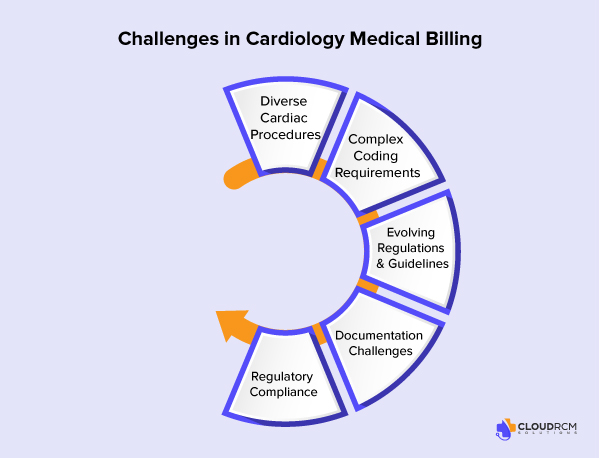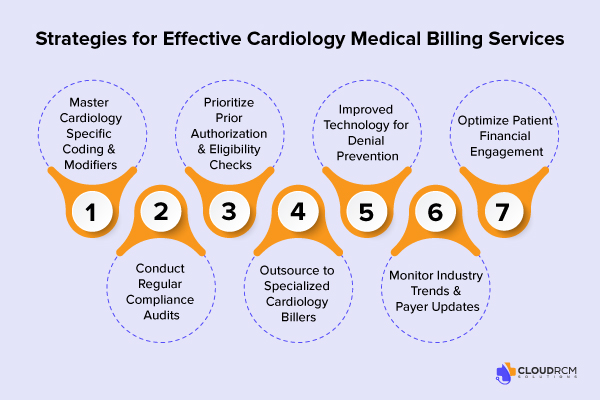Are you struggling with coding and billing for your cardiology practice? Cardiology is a crucial field in which patient care is the top priority of every healthcare provider. For complex cardiology procedures like pacemaker implants, cardiac catheterisations, and electrophysiology studies, even minor coding errors can lead to claim denial, delayed payments and lost revenue.
Let’s explore how specialised cardiology medical billing services can transform your practice’s financial health, so you can focus on saving lives and giving your patients exceptional care.
Why is medical billing crucial for cardiology?
Hiring and training in-house staff can be very costly. Regulatory policies and regulations are constantly evolving, and staying updated can be challenging. Outsourcing medical billing can ease your burden by reducing the chances of error and allowing you to focus on providing exceptional care to your patients.
Complexities in Cardiology Medical Billing

Cardiology medical billing services are very complex due to the wide range of procedures and treatments. Each service, ranging from diagnostic tests to invasive interventions, requires precise coding to ensure accurate reimbursement and compliance with regulatory standards.
1. Diverse Cardiac Procedures
Cardiology covers both diagnostic and therapeutic services, including:
- Echocardiograms (CPT 93306): A non-invasive procedure using sound waves to create images of the heart in real time.
- Angioplasties (CPT 92928): A procedure to open blocked coronary arteries and restore blood flow to the heart.
- Electrophysiology Studies (CPT 93620): Tests to assess the heart’s electrical system and identify irregular heart rhythms.
Each of these procedures requires specific coding and documentation to capture all components accurately, such as the use of contrast, imaging techniques, and physician involvement.
2. Complex Coding Requirements
Cardiology medical billing primarily uses CPT codes and ICD-10-CM diagnosis codes. However, due to the intricate nature of cardiology procedures, multiple codes are often required to represent a single service accurately. For instance:
- An angioplasty procedure might involve additional codes for the insertion of stents or the use of drug-eluting materials.
- Coding for electrophysiology studies may require documentation for catheter placements and ablation procedures.
Moreover, cardiology frequently involves bundled procedures, where multiple services are billed under a single code. Billing professionals must be vigilant to avoid unbundling errors that can result in claim denials.
3. Evolving Regulations and Guidelines
The American Medical Association (AMA) regularly updates CPT codes to reflect advancements in medical technology and procedures. In recent years, changes have been made to accommodate telehealth consultations and emerging cardiac devices like leadless pacemakers. Failure to stay updated on these changes can lead to claim errors and revenue loss.
4. Documentation Challenges
Accurate documentation is essential for cardiology billing to capture the complexity of procedures. Billing professionals must ensure that documentation includes:
- Detailed procedure descriptions
- Physician notes and reports
- Use of specialized devices and techniques
Incomplete or inaccurate documentation can lead to claim denials, audits, and legal consequences for cardiology practices.
5. Regulatory Compliance
Cardiology practices must navigate various regulations, including those from the Centers for Medicare & Medicaid Services (CMS) and private insurers. Compliance with rules related to medical necessity, pre-authorizations, and proper coding is crucial. Additionally, cardiology billing must adhere to the Health Insurance Portability and Accountability Act (HIPAA) to protect patient information.
Strategies for Effective Cardiology Medical Billing Services:

Cardiology practices face unique billing challenges, from complex procedural coding to evolving payer regulations. With 20-30% of cardiology claims initially denied due to errors (AAPC, 2023), adopting targeted strategies is critical to safeguarding revenue and streamlining workflows. Here’s how to optimize your cardiology billing process for accuracy, efficiency, and patient satisfaction.
1. Master Cardiology-Specific Coding & Modifiers (2025 Update)
Cardiology’s procedural complexity demands absolute coding accuracy. For example, billing a cardiac catheterization (CPT 93458) requires detailed documentation of imaging views, contrast use, and physician interpretations. Errors in coding not only delay reimbursement but can also trigger compliance risks.
Common Coding Pitfalls in Cardiology
- Misapplied Modifiers – Modifier 25 (significant, separately identifiable E/M service) is frequently applied incorrectly when billing stress tests.
- Bundling Errors – Echocardiography (93306) is often billed without bundling related Doppler studies, leading to denials.
- Incomplete Documentation – Missing details on contrast use, fluoroscopy time, or mapping can significantly reduce reimbursement.
Key CPT Code Updates (2024–2025)
| CPT Code | Procedure | 2024–2025 Update |
|---|---|---|
| 93297 | Remote pacemaker monitoring | Telehealth billing rules expanded in 2024. In 2025, CMS requires documented patient-initiated data transmission for reimbursement. |
| 92933 | Coronary stent with atherectomy | Revised 2024 documentation standards. In 2025, bundled reporting rules clarify when additional stent placement (92928) can be billed separately. |
| 93653 | Electrophysiology ablation | Bundled with 3D mapping (93613) since 2024. In 2025, CMS clarified that intracardiac echocardiography (93662) may be billed only if separately medically necessary. |
| 93000–93010 | Standard ECG services | 2025 rules require documenting ordering provider and interpretation time when performed in hospital outpatient settings. |
| 93294–93299 | Remote cardiac device monitoring | Updated in 2025 to align with RPM (Remote Patient Monitoring) guidelines, requiring 16+ days of data within a 30-day cycle. |
2. Prioritize Prior Authorization & Eligibility Checks:
Cardiology denials stem from prior authorization gaps, especially for high-cost interventions like ICD implants. Implement:
- Real-time eligibility tools: Verify coverage for services like cardiac rehab (93797) instantly.
- AI-driven authorization platforms: Predict payer requirements using historical data.
3. Improved Technology for Denial Prevention:
Modern tools address cardiology’s billing pain points:
- AI Auditing: Flags coding errors (e.g., missing modifier 59 for staged PCI).
- Predictive Analytics: Identifies denial patterns (e.g., Medicare’s LCD policies for echocardiograms).
- Integrated EHR Systems: Syncs Epic or Cerner with billing software for seamless claims submission.
4. Optimize Patient Financial Engagement
Transparent billing builds trust and reduces bad debt:
- Customized Estimates: Provide out-of-pocket costs for stress tests (93015) upfront.
- Flexible Payment Plans: Offer 0% interest options for costly procedures like TAVR (33361-33369).
- Digital Portals: Let patients view bills, pay online, or apply for financial aid.
5. Conduct Regular Compliance Audits
Cardiology’s regulatory landscape is stringent. Annual audits help:
- Avoid penalties under CMS’s 2024 Medicare Advantage audits.
- Align with HIPAA and No Surprises Act requirements.
- Update coding practices for value-based care models (e.g., MIPS).
Checklist for Audits:
- Review 10% of claims monthly.
- Validate modifier use (e.g., 26 vs. TC for imaging).
- Document shared decision-making for high-risk procedures.
6. Outsource to Specialized Cardiology Billers
| Aspect | In-House Billing | Outsourced Billing |
| Accuracy of Coding | Dependent on staff expertise and training | Specialized expertise in cardiology coding |
| Denial Management | Limited by internal resources and time | Proactive denial prevention and resolution |
| Cost Efficiency | Higher overhead (salaries, software, training) | Predictable, scalable cost structure |
| Payment Speed | Slower due to manual processes | Faster due to automation and streamlined workflows |
| Compliance | Risk of errors without dedicated audits | Built-in compliance checks and updates |
| Scalability | Challenging during workload spikes | Adapts seamlessly to practice growth |
| Technology & Tools | Requires ongoing investment in software/updates | Access to advanced billing platforms and AI |
| Focus on Patient Care | Staff split between billing and clinical tasks | Frees staff to prioritize patient care |
7. Monitor Industry Trends & Payer Updates
Stay ahead with proactive strategies:
- Value-Based Care: Transition from fee-for-service to outcome-driven reimbursements.
- Payer-Specific Rules: Track Aetna’s 2024 policies for coronary CTAs (75574) or UnitedHealthcare’s prior auth requirements for ablations.
The Role of Data Analytics in Optimization
Improving data analytics can significantly enhance cardiology medical billing services. By analyzing billing patterns, practices can identify areas of improvement, reduce claim denials, and optimize revenue. For instance, understanding the association between cardiologist billing patterns and healthcare utilization can inform strategies to balance service provision with financial performance.
Outsourcing as a Strategic Approach
The U.S. Medical Billing Outsourcing Market is projected to reach USD 5.9 billion in 2024, which is further anticipated to reach USD 16.9 billion by 2033 at a CAGR of 12.5%.. This trend reflects the increasing complexity of billing processes and the need for specialized expertise. Outsourcing cardiology medical billing services can lead to improved efficiency, reduced errors, and enhanced focus on patient care.
Final Thoughts:
Dealing with the complexities of cardiology medical billing can be challenging, but it is a crucial element in ensuring the financial health of your practice. The detailed procedures, evolving regulations, and documentation requirements can create room for errors that lead to claim denials and delayed reimbursements.
By outsourcing your billing needs to specialized experts like CloudRCM Solutions, you can reduce the risk of errors, increase claim approval rates, and free up your team to focus on what matters most providing excellent care to your patients, with tailored solutions and advanced technology.
Schedule a free appointment today to ensure your cardiology practice thrives both clinically and financially — feel free to reach out at (224) 231-6880
FAQs
Why is it important to know about the cardiovascular system when billing and coding?
Understanding the cardiovascular system ensures accurate coding for procedures and diagnoses, leading to proper reimbursement and compliance.
What is the CPT code for cardiology services?
Common cardiology service codes are in the range of 93000-93999, covering procedures like ECGs and stress tests.
What is the most difficult part of coding cardiology?
Navigating complex procedures and coding accurate modifiers for bundled services can be challenging.
What is the biggest challenge in medical billing?
Managing denied claims and keeping up with changing insurance regulations are major challenges.
What are the two most common types of medical billing?
Professional billing (for individual providers) and institutional billing (for hospitals) are the two most common types.
What is the biggest medical problem?
Cardiovascular diseases are the leading medical concern globally due to their high mortality rate.

 Medical Billing
Medical Billing Medical Coding
Medical Coding Medical Audit
Medical Audit Provider Credentialing
Provider Credentialing Denial Management
Denial Management A/R Follow-up
A/R Follow-up Private Practice
Private Practice Patient Help Desk
Patient Help Desk Customized Reporting
Customized Reporting Out-of-Network Billing
Out-of-Network Billing Internal Medicine
Internal Medicine Pediatrics
Pediatrics Radiology
Radiology Surgery
Surgery Emergency Medicine
Emergency Medicine Anesthesiology
Anesthesiology Cardiology
Cardiology Orthopedic
Orthopedic Psychiatry
Psychiatry Dentistry
Dentistry OB-GYN
OB-GYN Family Medicine
Family Medicine